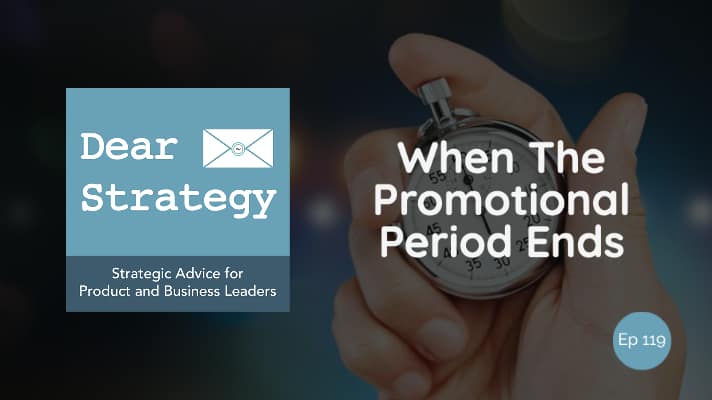On this episode of Dear Strategy, we analyze the practice of companies offering introductory pricing and we talk about what happens when those introductory pricing periods end. Companies have been doing this for ages, but there’s a right way to do it, and (at least from a customer’s perspective) a far less right way to do it. We’ll talk about some of the pros and cons of each.
We’ve all been through it. Some company offers you an introductory price for a subscription-based service. You sign up and integrate that service into your everyday life. A year goes by and you’ve long since forgotten about that introductory price, but you’re pretty quickly reminded of it when your price goes up without warning. And now you’re pissed. So you either call for another promotion, cancel the service altogether, or begrudgingly pay for the increase as you vow to switch to another service as soon as you possibly can. And, all the while, the question remains – is this a good strategy for the companies that are doing it?
To answer that question, we first need to explore why companies might do this in the first place. There are 3 main reasons that come to mind:
The most common reason to offer promotional or introductory pricing is for the purpose of gaining market share. The easiest way to gain new customers is, to quote a phrase, “make them an offer they can’t refuse!” The idea is that if you make it attractive enough for a customer to try out your products, they’ll somehow become hooked enough to want to pay full price at some point in the future. That’s the theory; although, of course, it doesn’t always happen that way. But more on that a bit later.
Another reason companies might employ the promotional pricing strategy is when they want to entice their existing customer base to upgrade to a new level of service. This is, more or less, the same theory as our first scenario, except that it is directed at growing revenue with your existing customers rather than with new customers. As a result, companies may be more likely to get the results they’re looking for from this type of strategy since their customers know exactly what to expect, and, generally, know exactly what it is that they’re signing up for.
The third reason a company might offer introductory or promotional pricing is to create a specific touchpoint with a customer. This is probably a less common reason, but it definitely does apply – particularly if the promotional period includes a free trial of some type. In this case, the company wants you to try their service for free, but also wants the opportunity to talk to you once your trial period ends. This not only gives them the ability to upsell you to their service (which is, of course, the ultimate goal), but also provides a critical feedback loop from those customers who aren’t interested in moving forward.
As you can see, all of these are solid and legitimate reasons to offer some sort of promotional or introductory period for subscription-based services. So, why, then, is this strategy so often met with anger and frustration when it’s implemented? The problem has less to do with the strategy itself and more to do with the way some companies are implementing it.
Customers want one thing above all else – honesty. And there are 2 basic ways that companies can violate their customers’ trust when it comes to promotional pricing. The first, and probably most common is when a company’s promotional period is designed to bring otherwise exorbitant prices down to reasonable market levels. So if a service is worth x, and a company’s promotion brings their prices from 2x down to x, customers don’t feel like they’re getting anything special out of the promotion. Instead, they feel like they’re getting temporarily unscrewed!
“Customers want one thing above all else – honesty.”
The second way that companies tend to violate their customers’ unwritten trust agreements is when they design their promotions to create reliance rather than desire. The point of a promotional period should be to entice customers to want to use your products. But when the promotion, instead, causes customers to become dependent on your products, they tend to feel trapped. And giving them no easy way out only serves to validate that response. So when customers get no warning that their promotions are about to end, have no idea what their “regular” pricing is going to be until they happen to see it on their bills, and are met with as much resistance as possible when they try to re-evaluate their options after their promotions have ended – these are all clear signs of companies who are using their promotions as traps rather than as lures. And there is a stark difference in the way those types of companies are going to be viewed by their customers over the long-term.
The bottom line is, promotional and introductory pricing is not at all a bad thing. But treating your customers with even the slightest hint of dishonesty is. So, if you’re thinking about implementing this type of strategy, my advice would be to not just be above board about it, but to go out of your way to make sure your customers know exactly what they’re getting into. It may be tempting to try to “sneak one by them” for the short-term win. But I just don’t see how that strategy will get you anywhere good in the end. Unless, of course, your goal is to create a large base of customers who absolutely hate doing business with you. In which case, I guess my advice would be “go for it!”
Listen to the podcast episode
Dear Strategy: Episode 119

Are you interested in strategy workshops for your product managers or business leaders? If so, please be sure to visit Strategy Generation Company by clicking the link below:
 Bob Caporale is the founder of Strategy Generation Company, the author of Creative Strategy Generation and the host of the Dear Strategy podcast. You can learn more about his work by visiting bobcaporale.com.
Bob Caporale is the founder of Strategy Generation Company, the author of Creative Strategy Generation and the host of the Dear Strategy podcast. You can learn more about his work by visiting bobcaporale.com.







